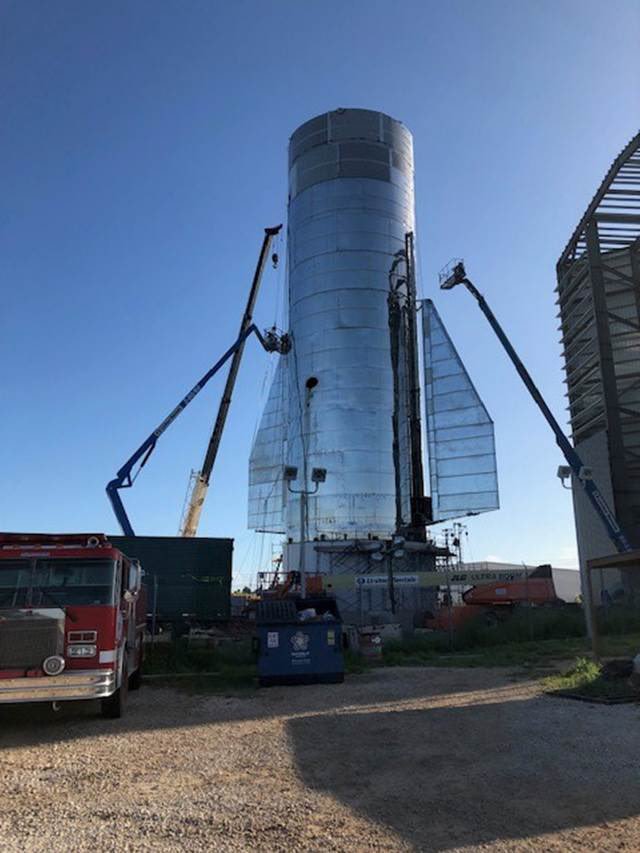Earlier today, Elon Musk posted another update via Twitter on the progress of the Starship prototype. Images taken from the company’s South Texas Launch Site near the town of Boca Chica show the Starship Mk.1 being equipped with two new tail fins. According to the usual Q&A that accompanied one of Musk’s post, these fins are intended to stabilize the Mk.1 during takeoff and landing.
Based on the image provided by Musk (below), the fins are mounted to the rear of the Mk.1 prototype and appear to be tapered around the bottom. The shape of these fins, plus the fact that they are two mounted on opposite sides of the spacecraft, led to some questions. In all previously-released iterations of the finished Starship (not to mention the Starship Hopper prototype), the fuselage had three rear-mounted fins.
In addition, these fins were more robust and angled outwards and towards the ground. This was clearly for the sake of providing the spacecraft with three landing legs, an essential feature that makes all of SpaceX’s boosters retrievable. However, Musk was sure to address these questions, as well as provide hints on what other features have been integrated into the Mk.1 and will be in the coming days and weeks.
For starters, he indicated that these two fins are steerable, whereas a smaller “leeward ‘fin'” would be added that would “simply be used as a leg” (aka. not be steerable). Stability during takeoff and landing, said Musk, would be controlled by the “(very) rapid movement of rear & fwd fins” as well as the Starship’s Attitude Control System (ACS) thrusters.
This is all in keeping with the company’s analysis of what would prove to be the most stable configuration for the orbital-class prototypes. As Muskput it:
“Current analysis, which I’m not fully bought into, suggests that 2 rear fins with separate airframe-mounted legs will be lighter, so this is the plan for Mk1/Mk2.
“For aero control, it comes down to % of cross-sectional area moving vs not. Flexible as to whether front or rear, so long as within bounds of center of mass & pressure.”
This update was posted on the morning of Sunday, Sept. 22nd. By evening, as he was getting ready to leave, Musk followed it up with more posts that featured more indications of their progress at Boca Chica. This included a video of stainless “raceway & flap hinge aero covers” being rolled out, as well as a shot of the rear-mounted fins and the fuselage of the Mk.1 as they appear at night.
The image was accompanied by Musk saying that the top half of the Mk.1 – the nose cone and header tanks – with the forward fins would be added “probably” by this Wednesday (Sept. 25th). Meanwhile, the three Raptor engines that will carry the prototype to suborbital altitudes for its test-run and then bring it in for a powered landing have already been installed.
All of this progress is indicative that Musk is looking to have the Mk.1 prototype ready in preparation for this coming weekend. During a presentation that is scheduled to take place on Saturday, Sept. 28th, Musk is expected to give an update on the design of the Starship‘s and provide additional details about its upcoming missions.
As for launch tests, SpaceX could be conducting launch tests using the full-scale prototype as early as October 13th, with an end date of April 13th, 2020 – according to the most recent FAA filings. These same filings indicate that this test will take place at their Boca Chica facility and will consist of an “Experimental launch, landing, and recovery of the Starship suborbital test vehicle from Boca Chica TX.”
Meanwhile, construction continues on the Starship Mk.2, the company’s second orbital-class prototype which is currently being assembled at SpaceX’s facility at Cape Canaveral, Florida. Both vehicles will test the capabilities of the launch system to higher altitudes and velocities than those achieved by the Starship Hopper.
If successful, these tests will bring the company closer to conducting commercial flights with the Starship and Super-Heavy launch system, which Musk hopes will commence by 2021. Musk also hopes to conduct an uncrewed lunar mission in that same year, followed by the first crewed flight that would see the Starship/Super-Heavy take a crew of artist’s around the Moon by 2023.
Further Reading: Twitter

